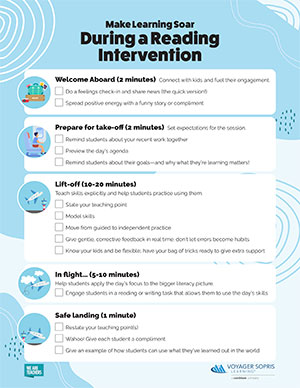Planning Reading Intervention for Your Elementary Students
Originally posted by WeAreTeachers
Wherever learning takes place, having a plan for explicit intervention instruction makes a difference.

Reading intervention for elementary school students who need it is a must-have for an effective literacy program.
Bolstering struggling readers’ skills with strategic supplemental instruction was essential before COVID-19. With the frantic shift to online learning during spring 2020, researchers estimate students may only retain 70 percent of a typical year’s reading progress when they start the 2020-2021 school year.
This means delivering effective reading intervention needs to be a priority, whether it happens face to face or remotely. Check out these five key considerations for planning reading intervention anywhere learning takes place:
Schedule the time
Struggling readers need extra teaching time. Literacy leader Dr. Louisa Moats lists adequate intervention time for struggling students to receive specialized instruction as a top necessity for achieving literacy for all. The exact amount of time will vary based on student age and need, but it’s wise to plan for intervention to occur four to five days/week for 20 to 40 minutes. Trained instructors are also key; struggling readers need knowledgeable teachers.
Scheduling reading intervention time could get tricky during COVID-19, but it can be done. Whenever possible, hybrid-schedule schools should take intervention needs into cohort schedule development. If education is remote, intervention needs to involve connecting with students’ families. Ask about their schedules and set expectations to ensure someone at home is available to offer specific supports or troubleshoot technology issues.
Assess students initially and routinely
Effective intervention can’t happen without information about students’ strengths and needs. Initial universal screening helps identify students who need intervention. Once intervention begins, observation and regular formative assessment data let teachers tailor their instruction and differentiate to support each student’s progress.
During remote learning, teachers may have to get creative to gather assessment data. Having one student stay online after each small-group video session, scheduling one-on-one video calls, or using online assessment tools could be options. Help caregivers understand the function and importance of assessment. That way, they can encourage students’ authentic participation in assessment tasks.
Adopt a comprehensive scope and sequence
Assessing elementary students helps identify skill gaps, but that still doesn’t negate the importance of a solid curriculum. In particular, experts Nell K. Duke and Heidi Mesmer highlight the importance of teaching phonics skills in an intentional sequence. This helps students to create mental “file folders” of related principles and boosts retention.
While attention to phonics is crucial, intervention has to address the whole literacy picture; build in time for explicit instruction in phonological awareness, fluency, vocabulary, and comprehension too.
Share a high-level scope and sequence with any caregivers helping support learning at home, so they know what students have learned and where they are headed next.
Plan ahead for explicit instruction and practice time
Equip teachers with the planning time and materials they need, like student manipulatives and texts. Being prepared for each intervention session will make scheduled time with students count. This free reading intervention checklist can help. Each lesson should include a strategically paced blend of direct teaching, guided practice, and independent practice that shows teachers where they need to go next. Teachers must be trained to provide corrective feedback to quickly address any student misconceptions.
For intervention delivered remotely, investigate ways to mix synchronous and asynchronous teaching. Share resources such as video clips that model concepts like letter-sound associations so consistent and correct modeling can continue outside of live intervention sessions. Video clips of the production of spoken sounds are also helpful during face-to-face teaching if the teacher must wear a mask. For live online teaching, move multisensory practice online, for instance by creating letter tiles in Google Slides or Google Drawing. Or, arrange for students to have their own set of manipulatives at home.
Always plan to connect isolated skills to authentic reading and writing
Discrete skills are meaningless if students can’t use them in their broader reading and writing lives. Structure the intervention cycle so students get explicit teaching. Then, give students chances to apply those skills to reading and writing connected text. When assigning reading and writing assignments for other classroom time or home, model how students could apply skills they have learned in intervention lessons.
Voyager Passport® supplemental reading intervention provides struggling readers with explicit instruction, corrective feedback, and more time on task to master critical reading skills—in just 30 minutes a day. Flexible for use in remote, hybrid, and face-to-face delivery formats. Click the button below to get a free Voyager Passport lesson sample.


